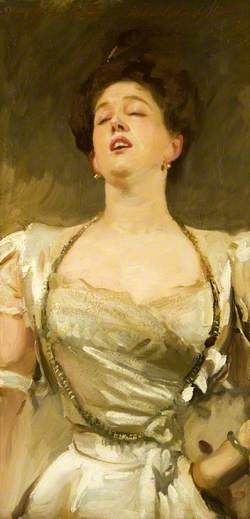How you can use this image
This image is available to be shared and re-used under the terms of the Creative Commons Attribution-NonCommercial-NoDerivatives licence (CC BY-NC-ND).
You can reproduce this image for non-commercial purposes and you are not able to change or modify it in any way.
Wherever you reproduce the image you must attribute the original creators (acknowledge the original artist(s) and the person/organisation that took the photograph of the work) and any other rights holders.
Review our guidance pages which explain how you can reuse images, how to credit an image and how to find more images in the public domain or with a Creative Commons licence available.
DownloadNotes
Add or edit a note on this artwork that only you can see. You can find notes again by going to the ‘Notes’ section of your account.
The inspiration for this picture came during a boating expedition Sargent took on the Thames at Pangbourne in September 1885, with the American artist Edwin Austin Abbey, during which he saw Chinese lanterns hanging among trees and lilies. He began the picture while staying at the home of the painter F. D. Millet at Broadway, Worcestershire, shortly after his move to Britain from Paris. At first he used the Millets's five-year-old daughter Katharine as his model, but she was soon replaced by Polly and Dorothy (Dolly) Barnard, the daughters of the illustrator Frederick Barnard, because they had the exact haircolour Sargent was seeking. Dolly, aged eleven, is on the left; Polly, aged seven, is on the right. A sketchbook at the Fogg Museum, Cambridge, includes Sargent's outline designs for the painting, and two drawings at the Tate (Tate Gallery A00850-1) record the precise poses he required for the girls' profiles.
Edwin Howland Blashfield, a member of the artists' colony at Broadway that year, recalled that when he saw the canvas each morning, the previous evening's work seemed to have been scraped off, and that this happened repeatedly at each stage. Sargent cut two feet off the left side of the canvas, leaving it approximately square, in order to concentrate the composition. The picture was both acclaimed and decried at the 1887 Royal Academy exhibition. The title comes from the song 'The Wreath', by the eighteenth-century composer of operas Joseph Mazzinghi, which was popular in the 1880s. Sargent and his circle frequently sang around the piano at Broadway. The refrain of the song asks the question 'Have you seen my Flora pass this way?' to which the answer is 'Carnation, Lily, Lily, Rose'. The picture was bought for the Tate Gallery in 1887, under the terms of the Chantrey bequest, largely at the insistence of the Royal Academy President, Sir Frederic Leighton. A portrait by Sargent of Mrs Barnard (1885), made at the same time as 'Carnation, Lily, Lily, Rose', is also in the Tate (Tate Gallery N05901).
Further reading: The Hon. Evan Charteris, 'John Sargent', London 1927, pp.74–75, 78, 83–84, 96, 178, 252 Mary Chamot, Dennis Farr and Martin Butlin, 'Tate Gallery Catalogues: The Modern British Paintings, Drawings and Sculpture, II', London 1965, pp.587–588 Terry Riggs February 1998
Title
Carnation, Lily, Lily, Rose
Date
1885–6
Medium
Oil on canvas
Measurements
H 174 x W 153.7 cm
Accession number
N01615
Acquisition method
Presented by the Trustees of the Chantrey Bequest 1887
Work type
Painting








